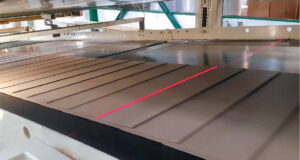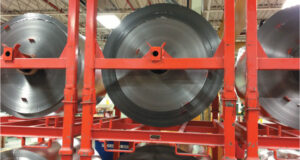
If you ask a containerboard manufacturer about their most pressing demands when it comes to technology, the answer will depend on their location and the needs of their customers. Yet certain criteria will arise every time. Containerboard grades require reliable strength properties, high productivity, and reduced specific energy consumption combined with a very low total cost of ownership.
FILLING A GAP?
Technology and application experts must work together with customers, always aiming to establish a holistic solution approach that covers the entire process from stock preparation or even pulp milling through to the final product. Nevertheless, the complete solution is of course the sum of its parts.
With this in mind, Andritz’s PrimeForm TW gap former has proved to be a welcome solution for rebuilds and greenfield projects alike. It is based on a unique shoe-blade gap former concept that has specific features and advantages in the crucial impingement zone, where the paper is actually formed.
In recent years, several PrimeForm TW gap formers have been ordered globally in different containerboard markets. Critically, PrimeForm TW has proved its ability to make heavy-grade containerboard using a singleply concept with no internal strength issues, partly thanks to its industry-leading dewatering mechanics and capacity. Reference customers have solutions that span more than 250 g/m2 (0.05 lb/ft2) and range from lightweight packaging up to the fastest heavyweight kraftliner gap former in the world with a working width of nearly 10 m. The furnish has also varied, from various qualities of recycled OCC to virgin fiber kraft and mechanical pulp.
From containerboard customers in particular, Andritz has seen an increasing demand for maximum strength properties, especially in the cross-machine direction (CD). That is why we have engineered the impingement shoe at the heart of our PrimeForm TW gap forming technology, aiming not only to maximize the dewatering capacity, but also to minimize pulsation. The patented pulsation-free forming shoe with varying curvature provides impressive overall strength properties at very low MD/ CD ratios. Pulsation has the effect of aligning fibers, whereas the ideal scenario for strength is to balance the MD/CD strength to achieve the optimum ratio. For the highest demands in terms of capacity, Andritz can offer a unique double shoe concept.
DECISIVE DEWATERING
A high dewatering capacity enables more water to be transferred with a given quantity of fibers, which is beneficial for several quality parameters. In the case of kraftliner, for example, there is a need for very long fibers that will only yield a good paper web with significant dilution. So, in the absence of a high dewatering capacity, it will either be impossible to produce the paper at an acceptable quality, or only be possible to do so by sacrificing productivity.
The shoe-blade former is the ideal concept for new lines in terms of both energy savings and quality. However, as evidenced by recent start-ups and orders, customers are also choosing PrimeForm TW for converting existing gap formers. The wide operating window is a key advantage in the eyes of paper and board makers.
In the case of rebuilds, the ability to produce in a single ply can be critical for the project’s success, and this is dependent on dewatering capacity. To achieve the highest quality, a two- or three-ply concept would usually be chosen to enable split dewatering between plies and enhance quality. Yet this also involves a higher investment and depends on boundary conditions such as energy consumption and, especially in the case of rebuilds, the space available for the rebuilt forming section.
THE ENERGY QUESTION
As mentioned, the highest quality containerboard can be produced in a single ply, especially when PrimeForm TW is used in combination with Andritz’s multi-layer headboxes. There are also further aspects of efficiency to consider: compared to a multi-ply forming concept, single-ply containerboard production brings significant energy savings for the approach flow, drives, vacuum, and beyond.
The improved strength properties of a shoe-blade gap former base paper also help to reduce the energy required by a containerboard line because the starch application or refining can be reduced, or lighter basis weights are possible to meet the same final product demands.
Alongside the PrimeForm TW shoe-blade gap former, the Andritz high-performance PrimePress X shoe press may be the most energy-saving device in the containerboard production process. We can offer shoe presses for very high dry contents and, for special applications, have introduced innovative shoe presses with line loads of up to 2000 kN/m and customized shoe profiles achieving a much higher post-press dryness—up to 59 percent higher in some cases.
Specific steam energy savings of 10 percent are realistic compared to lines with conventional shoe presses. As with PrimeForm TW, these high-performance shoe presses also have a positive influence on the strength properties of the base paper.
‘PRIME’ EXAMPLE: HOLMEN
Among examples of PrimeLine technology applications, Andritz has been commissioned to rebuild graphic paper PM52 at Holmen Paper Braviken in Sweden to achieve utmost production flexibility with a unique swing-mode concept. Startup is planned for autumn 2024.
Ola Schultz-Eklund, senior vice president technology at Holmen Group, explains. “When we entered the packaging grade market with innovative lightweight containerboard grades based on 100 percent thermomechanical pulp (TMP), the market response was so positive that the decision was made to improve the end-product quality, widen the operating window of basis weights on PM52 and raise production capacity,” she notes.
Adds Gerald Steiner, Andritz vice president paper and board, “The challenge is to enable a unique flexibility by producing book paper and newsprint along with new containerboard grades. On the one hand, TMP furnish-based containerboard requires extremely high dewatering capacity and the lowest possible MD/CD ratios. On the other hand, book paper needs excellent formation and homogeneous filler retention. We carried out proof-of-concept pilot trials with Holmen Paper and jointly developed a swing-mode concept.”
Moving west, another line to be delivered in Canada in the near future will have the ability to run super-light specialty grades and kraftliner with a much higher basis weight on the same former.
‘PRIME’ EXAMPLE: STEYRERMÜHL
Back in Europe, Andritz is scheduled to convert the idled graphic PM3 at Steyrermühl mill in Austria in 2024 to produce kraft papers for sustainable flexible packaging. The conversion project was launched by Heinzel Group, which will take over the Steyrermühl mill from UPM by January 1, 2024.
Once rebuilt, the paper machine (renamed PM6) will produce up to 150,000 tpy of brown and white kraft paper, with a low basis weight, under the Heinzel Group’s well-established StarKraft brand. The paper will be used for shopping bags, pouches, and other flexible packaging.
Werner Hartmann, COO of Heinzel Pöls, says, “With this investment, StarKraft will become one of the world’s leading brands for bleached and unbleached kraft paper. Andritz PrimeLine technology is already successfully operating at our Pöls and Laakirchen mills. The current rebuild by Andritz will help us expand our product portfolio for sustainable packaging.” The lines at Pöls represent Europe’s largest new MG paper machines (PM2 and PM3).
The production of such kraft paper usually requires a Fourdrinier former. By using the PrimeForm TW shoe-blade gap former, however, PM6 will benefit from paper strength development and outstanding dewatering performance, combined with dilution control for excellent cross profiles thanks to a PrimeFlow AT headbox. With Andritz’s advanced gap forming technology, PM6 at Steyrermühl will achieve significant energy savings while producing high-quality end products.
INFORMED DECISIONS
Andritz’s customers appreciate the possibility of running trials at the pilot facility in Montreal, Canada, where they can focus on PrimeForm TW shoe-blade configuration using their chosen furnish. All the recent Andritz kraftliner installations were developed based on pilot trials, as was the production of containerboard made of mechanical pulp, all supported by Andritz’s pulp and stock-prep pilot facilities.
It is also worth noting that Andritz’s overall competence has certainly benefited from its acquisition of Xerium a few years ago, which brought the invaluable contribution of fabric and roll expertise to the group.
The variation in the nature and quality of furnish available across different geographical markets emphasizes the importance of pilot trials. These trials have shown that all furnishes are compatible with Andritz’s forming concept. Recent orders for the packaging shoe-blade gap former will be operated with virgin kraft, mechanical pulp, as well as OCC sourced in North America, Europe, and a well-known containerboard producer in Australia.
As board producers seek flexible solutions giving them the power to adapt to ever-changing market conditions and fiber supply realities, the PrimeForm TW shoe-blade configuration is very much the technology of the future.
 Paper 360
Paper 360

